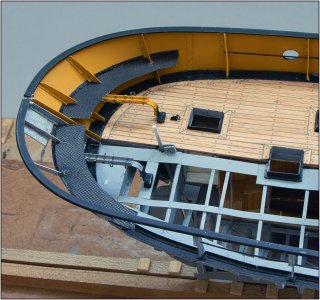What a treasure!
-

Win a Free Custom Engraved Brass Coin!!!
As a way to introduce our brass coins to the community, we will raffle off a free coin during the month of August. Follow link ABOVE for instructions for entering.
You are using an out of date browser. It may not display this or other websites correctly.
You should upgrade or use an alternative browser.
You should upgrade or use an alternative browser.
BALDER, Vlaardingen Herring Lugger from 1912, scratch build scale 1:50 Plate-On-Frame
- Thread starter Peter Voogt
- Start date
- Watchers 64
Good afternoon Peter. Your log is like a beautiful bike trip with something exquisite around each corner…..wonderful. Cheers Grant
- Joined
- Sep 3, 2021
- Messages
- 5,137
- Points
- 738

I was able to see her in the flesh today and, boy, what a model to behold!
It's a pity Peter's ideas on ship-modeling haven't attracted any trend-followers yet; I discovered I every much enjoy these so-called skeleton models and Peter's approach is very informative for those interested.
Thanks for your hospitality, the coffee and the delicious bokkepoot.
It's a pity Peter's ideas on ship-modeling haven't attracted any trend-followers yet; I discovered I every much enjoy these so-called skeleton models and Peter's approach is very informative for those interested.
Thanks for your hospitality, the coffee and the delicious bokkepoot.
That's for sure, Paul. And it's luxury large format with a hard cover. And for 'second hand' it's looking as new.What a treasure!
Regards, Peter
Last edited:
That's a nice new description, Grant. The journey to something is more important than reaching the destination.Good afternoon Peter. Your log is like a beautiful bike trip with something exquisite around each corner…..wonderful. Cheers Grant
Still have a long way to go .....
Regards, Peter
Thanks for your visit and these very nice words, Johan. You are always welcome. (Other SoS members too, you know.)I was able to see her in the flesh today and, boy, what a model to behold!
It's a pity Peter's ideas on ship-modeling haven't attracted any trend-followers yet; I discovered I every much enjoy these so-called skeleton models and Peter's approach is very informative for those interested.
Thanks for your hospitality, the coffee and the delicious bokkepoot.
Regards, Peter
I did some work on the aft side.
I'd already shown how the sloop is mounted on supports there:
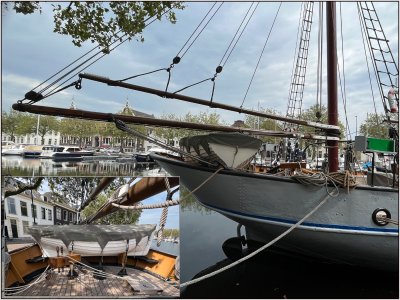
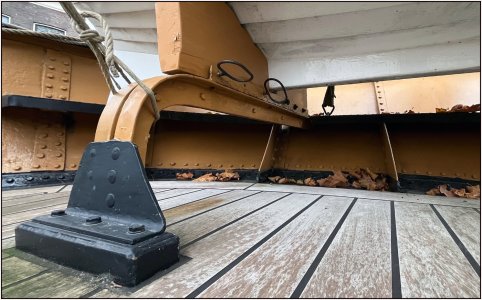
During the time that the sloop is being painted, the supports were more visible.
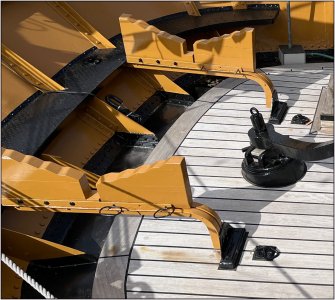
Everything's neatly painted again.
I'd already made the support on the starboard side. Now I've done the same on the port side:
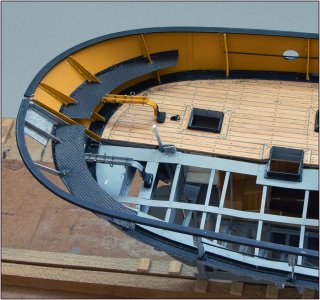
I won't make the four blocks that hold the sloop in place until I've built the sloop. Then I can make them to the shape of the hull.
And now I can also determine the sloop's size so that it fits within the bulwark and above the "koekepan".
For now, I've only made the lashing eye on the port deck. And I forgot to glue the lashing to the "frying pan" as well... My intention is to secure the sloop to the port support in such a way that I can separate both halves without removing the sloop. Because then I'd have to loosen the lashing as well. It’s on the list of other challenges I still have to work out .......
My intention is to secure the sloop to the port support in such a way that I can separate both halves without removing the sloop. Because then I'd have to loosen the lashing as well. It’s on the list of other challenges I still have to work out .......
Regards, Peter
I'd already shown how the sloop is mounted on supports there:


During the time that the sloop is being painted, the supports were more visible.

Everything's neatly painted again.
I'd already made the support on the starboard side. Now I've done the same on the port side:

I won't make the four blocks that hold the sloop in place until I've built the sloop. Then I can make them to the shape of the hull.
And now I can also determine the sloop's size so that it fits within the bulwark and above the "koekepan".
For now, I've only made the lashing eye on the port deck. And I forgot to glue the lashing to the "frying pan" as well...
Regards, Peter
Bolts and pins perfectly represented, Peter. A tour de force in precision modeling.
Thanks, Paul. Having reference pictures of the original Balder has its pros and cons. So far the advantages ........ but is has it's limits.Bolts and pins perfectly represented, Peter. A tour de force in precision modeling.
Regards, Peter
Thanks, Maarten. Vlaardingen is famous for its gigantic Japanese Saw ...........

Regards, Peter
With the tiller still fresh in my mind, I set to work on it.
An overview:
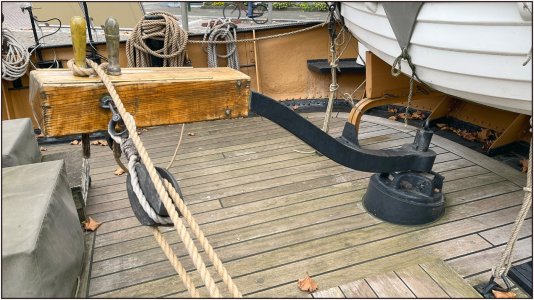
With a bearing to secure the rudder stock, on top of that the metal tiller, with a wooden reinforcement at the end into which two large belay pins are inserted. And on de sides a single sheave blok.
Some details:
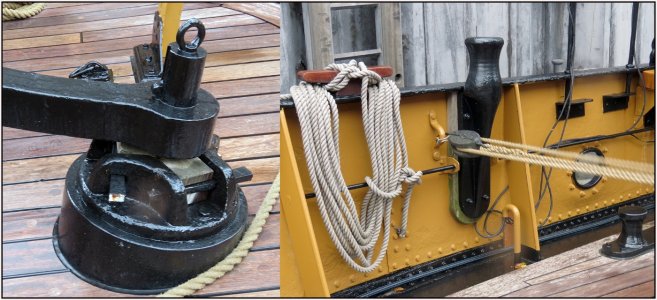
The bearing with pieces of hard wood on three sides, each secured with a wedge. On the inside of the bulwark is a metal bracket to which a single sheave block is hooked.
Various components are also detailed on drawings I obtained from the Amsterdam archives:
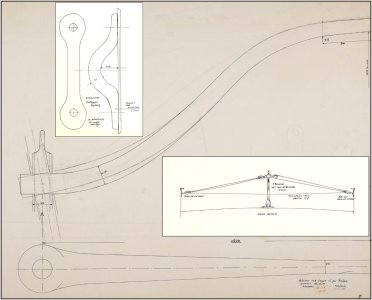
I have pasted two other details in the drawing of the tiller. Top left is the metal bracket with the caption "Brackets for steering tackle, 2 pieces."
There is also a schematic representation of "the steering system," with "circular tackle, manila 25 ø" and on the right side "block with becket and hook."
This has been adjusted on the Balder:
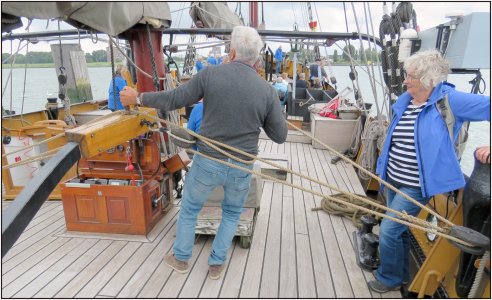
There are now two loose ends coming from the side blocks. Here, the skipper holds both of them in his right hand as we sail sharply out of Maassluis harbor. This puts a lot of force on the rudder. A moment later, he releases the port end and pulls strongly on the rudder, supported by the tightening starboard tackle.
This is how it turned out on my Balder:
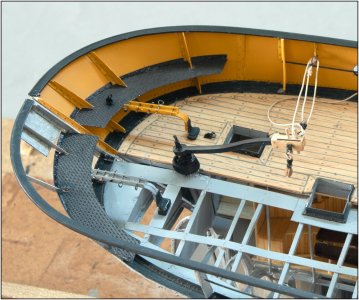
Only the port tackle is reeved.
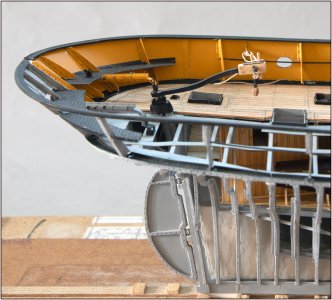
On the wooden end, the two wooden belay pins and on top, on either side the metal strips to prevent wear on the lines and block.
View of the bearing:
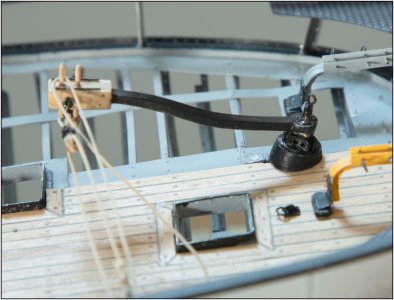
The three wedged wooden nuts are just visible.......
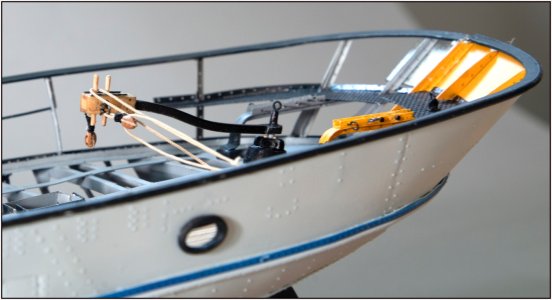
I still need to figure out something to tighten the lines a bit. Some clear varnish on them? On the other hand: everything is in rest.
Regards, Peter
An overview:

With a bearing to secure the rudder stock, on top of that the metal tiller, with a wooden reinforcement at the end into which two large belay pins are inserted. And on de sides a single sheave blok.
Some details:

The bearing with pieces of hard wood on three sides, each secured with a wedge. On the inside of the bulwark is a metal bracket to which a single sheave block is hooked.
Various components are also detailed on drawings I obtained from the Amsterdam archives:

I have pasted two other details in the drawing of the tiller. Top left is the metal bracket with the caption "Brackets for steering tackle, 2 pieces."
There is also a schematic representation of "the steering system," with "circular tackle, manila 25 ø" and on the right side "block with becket and hook."
This has been adjusted on the Balder:

There are now two loose ends coming from the side blocks. Here, the skipper holds both of them in his right hand as we sail sharply out of Maassluis harbor. This puts a lot of force on the rudder. A moment later, he releases the port end and pulls strongly on the rudder, supported by the tightening starboard tackle.
This is how it turned out on my Balder:

Only the port tackle is reeved.

On the wooden end, the two wooden belay pins and on top, on either side the metal strips to prevent wear on the lines and block.
View of the bearing:

The three wedged wooden nuts are just visible.......

I still need to figure out something to tighten the lines a bit. Some clear varnish on them? On the other hand: everything is in rest.
Regards, Peter
Last edited:
Perhaps an inconspicuous rudder stop at mid point allowing your line work to be pulled taught?I still need to figure out something to tighten the lines a bit. Some clear varnish on them?
- Joined
- Jun 17, 2021
- Messages
- 3,168
- Points
- 588

Awsome!
Superb adventure and pictures Peter, most interestingYesterday I had a pleasant day in the area where I grew up in my youth. An organization in Maassluis, together with one in Vlaardingen, organizes their so-called "Rondje Zoet en Zout" ("Fresh and Salt Tour") ...

Thanks for the idea, Daniel. I hope that the tiller and rudder remains there function.Perhaps an inconspicuous rudder stop at mid point allowing your line work to be pulled taught?
Will do first a test with some diluted glue that dries up transparent.
Regards, Peter
Awsome!
Thanks for the compliments, Pete and Mark.Superb adventure and pictures Peter, most interesting
Regards, Peter
- Joined
- Apr 20, 2020
- Messages
- 6,177
- Points
- 738

incalculable work!!!With the tiller still fresh in my mind, I set to work on it.
An overview:
View attachment 537542
With a bearing to secure the rudder stock, on top of that the metal tiller, with a wooden reinforcement at the end into which two large belay pins are inserted. And on de sides a single sheave blok.
Some details:
View attachment 537543
The bearing with pieces of hard wood on three sides, each secured with a wedge. On the inside of the bulwark is a metal bracket to which a single sheave block is hooked.
Various components are also detailed on drawings I obtained from the Amsterdam archives:
View attachment 537544
I have pasted two other details in the drawing of the tiller. Top left is the metal bracket with the caption "Brackets for steering tackle, 2 pieces."
There is also a schematic representation of "the steering system," with "circular tackle, manila 25 ø" and on the right side "block with becket and hook."
This has been adjusted on the Balder:
View attachment 537545
There are now two loose ends coming from the side blocks. Here, the skipper holds both of them in his right hand as we sail sharply out of Maassluis harbor. This puts a lot of force on the rudder. A moment later, he releases the port end and pulls strongly on the rudder, supported by the tightening starboard tackle.
This is how it turned out on my Balder:
View attachment 537546
Only the port tackle is reeved.
View attachment 537547
On the wooden end, the two wooden belay pins and on top, on either side the metal strips to prevent wear on the lines and block.
View of the bearing:
View attachment 537548
The three wedged wooden nuts are just visible.......
View attachment 537549
I still need to figure out something to tighten the lines a bit. Some clear varnish on them? On the other hand: everything is in rest.
Regards, Peter
It might be easier to leave that rig at rest, without tension, hanging... it's an idea.
It might be easier to leave that rig at rest, without tension, hanging... it's an idea.With the tiller still fresh in my mind, I set to work on it.
An overview:
View attachment 537542
With a bearing to secure the rudder stock, on top of that the metal tiller, with a wooden reinforcement at the end into which two large belay pins are inserted. And on de sides a single sheave blok.
Some details:
View attachment 537543
The bearing with pieces of hard wood on three sides, each secured with a wedge. On the inside of the bulwark is a metal bracket to which a single sheave block is hooked.
Various components are also detailed on drawings I obtained from the Amsterdam archives:
View attachment 537544
I have pasted two other details in the drawing of the tiller. Top left is the metal bracket with the caption "Brackets for steering tackle, 2 pieces."
There is also a schematic representation of "the steering system," with "circular tackle, manila 25 ø" and on the right side "block with becket and hook."
This has been adjusted on the Balder:
View attachment 537545
There are now two loose ends coming from the side blocks. Here, the skipper holds both of them in his right hand as we sail sharply out of Maassluis harbor. This puts a lot of force on the rudder. A moment later, he releases the port end and pulls strongly on the rudder, supported by the tightening starboard tackle.
This is how it turned out on my Balder:
View attachment 537546
Only the port tackle is reeved.
View attachment 537547
On the wooden end, the two wooden belay pins and on top, on either side the metal strips to prevent wear on the lines and block.
View of the bearing:
View attachment 537548
The three wedged wooden nuts are just visible.......
View attachment 537549
I still need to figure out something to tighten the lines a bit. Some clear varnish on them? On the other hand: everything is in rest.
Regards, Peter
Thanks for this compliment, Shota.incalculable work!!!
Regards, Peter


